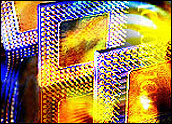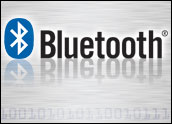Hailed as the “next big thing” in computing during the 1980s, optical technology was supposed to revolutionize everything from networks to processors. But the pace of research cooled when materials used to make optical chips — which convey light, or photons, rather than electrons, as in traditional semiconductors — failed to emerge.
The computer industry has been interested in optical computing because of the possibility that conventional electronics will soon reach the limits of miniaturization. The growth of the Internet has, moreover, fostered demand for faster-speed, larger-bandwidth networks — the kind of networks that are more efficient and powerful than electronic circuits can provide.
Conventional electronic switching networks limit network speeds to around 50 gigabits per second. One gigabit is 1 billion bits. The general consensus is that the industry will need Terabit speeds to accommodate future demands on the Net. One terabit is 1 trillion bits.
Based on quantum mechanics, a theory Albert Einstein formulated in the early 20th century about the mechanics of light molecules, optical computing is, nearly 100 years later, finally coming of age.
Coming of Age
Today, optical technology is being promoted for use in storage area networks (SANs), parallel processing, optical switches, all-optical data networks, holographic storage devices, and even biometric devices at airports to track potential terrorists.
“The optical technology that is emerging is starting to remind me of something that would be in the Tom Cruise movie Minority Report,” said Grant Evans, CEO of A4Vision, a maker of optical facial-recognition technology. “We’re going to have computers, not too long from now, that don’t have screens and where the information is presented as a hologram in the air above a keyboard,” he told TechNewsWorld.
To make this kind of technology possible, researchers at universities around the world — working with industry — have developed new conducting polymers to create transistor-like switches that are smaller and 1,000 times faster than silicon transistors.
In the Net
The optical networking business — the most practical application of optical technology in use today — is likely to grow to US$3.5 billion by 2007 from $1 billion today, according to a recent report by In-Stat/MDR, a market research firm.
Small, innovative optical networking equipment makers, such as Chiaro Networks, Procket, and Caspian Networks, are struggling against larger, more traditional networking companies to shape this market.
“The main question is whether Chiaro has the necessary customer service support and sales talent to erode Juniper’s and Cisco’s market share,” a report by research firm Gartner Dataquest indicates.
Doing the Impossible
Chiaro Networks, a privately held firm based near Dallas, Texas, with R&D offices in Israel, is one of the latest technological entrants into the optical network market. The company’s Enstara router platform is an optical switch-based Internet Protocol router that uses nonblocking optical packet switching, a new technology capable of forwarding almost 8 billion packets per second.
The company calls the platform the world’s first IP core router based on an optical switch fabric. “This is perhaps 1,000 times the capacity of conventional packet switching,” says Eyal Shekel, founder of Chiaro Networks. “When we first started working on this technology, many people told us it could not be done.”
The key technology developed at Chiaro is called the optical phased array, a technology originally conceived for use in laser scanners. Although the design is a trade secret, Shekel claims the creation is based on “very simple physics.”
Light Security
Another practical use of the optical technology is biometric identification. A4Vision, a company that makes a facial-recognition system based on optical technology, will be providing the U.S. government with infrared and optical identification technology used to track those entering the United States.
More blue-sky optical computing projects, though, are being developed in academia and government research laboratories, including at the University of Colorado, the University of Rochester, and NASA.
Researchers at the University of Rochester, for example, have built a simple optical computer that demonstrates that optical computing can conduct huge computations nearly instantly. The research is ongoing but could lead to a computer that is more than a billion times faster than today’s supercomputers.
A Million Librarians
Regular, semiconductor-based computers use electrons — particles that orbit atoms — to perform tasks sequentially. One researcher compared electron-based computing to having one librarian looking for a book in a library, one book at a time. But by using quantum computing, light can be used to perform tasks simultaneously, as if a million librarians were looking at a million books simultaneously.
Scientists at NASA have developed and built all-optical logic gate circuits for data processing, researchers at IBM’s Almaden Research Center have developed ultrafast data storage devices that use laser pulses, and NEC has been working on electro-optical hybrids, a combination of conventional and optical computing.
“There are many applications that will become available, a year or two from now, based on optical switching,” Shekel told TechNewsWorld. “The future of optical computing is now arriving.”






















































using ferroelectric atomic, photonic, molecular switch patented by Michael E. Thomas.
.
Search for Colossal Storage Corporation’s website
if interested in reading further about the technology.